Exploring the Effect of V2O5 and Nb2O5 Content on the Structural, Thermal, and Electrical Characteristics of Sodium Phosphate Glasses and Glass–Ceramics
Abstract
1. Introduction
2. Results and Discussion
2.1. General Properties and Thermal Behaviour
2.2. PXRD and SEM-EDS Analysis
2.3. Vibrational Spectroscopy—Raman and IR-ATR Studies
2.4. Electrical Properties
2.4.1. Complex Impedance Plane and Direct Current (DC) Conductivity
2.4.2. DC Conductivity and Activation Energy
2.4.3. Scaling Properties of Conductivity Spectra
2.5. Influence of V2O5 Content on the Mechanism of Electrical Conductivity
3. Materials and Methods
4. Conclusions
Supplementary Materials
Author Contributions
Funding
Institutional Review Board Statement
Informed Consent Statement
Data Availability Statement
Acknowledgments
Conflicts of Interest
References
- Singh:, A.N.; Islam, M.; Meena, A.; Faizan, M.; Han, D.; Bathula, C.; Hajibabaei, A.; Anand, R.; Nam, K.-W. Unleashing the Potential of Sodium-Ion Batteries: Current State and Future Directions for Sustainable Energy Storage. Adv. Funct. Mater. 2023, 33, 2304617. [Google Scholar] [CrossRef]
- Zhao, C.; Liu, L.; Qi, X.; Lu, Y.; Wu, F.; Zhao, J.; Yu, Y.; Hu, Y.-S.; Chen, L. Solid-State Sodium Batteries. Adv. Energy Mater. 2018, 8, 1703012. [Google Scholar] [CrossRef]
- Austin, I.G.; Mott, N.F. Polarons in Crystalline and Non-Crystalline Materials. Adv. Phys. 1969, 18, 41–102. [Google Scholar] [CrossRef]
- Thirupathi, R.; Kumari, V.; Chakrabarty, S.; Omar, S. Recent Progress and Prospects of NASICON Framework Electrodes for Na-Ion Batteries. Prog. Mater. Sci. 2023, 137, 101128. [Google Scholar] [CrossRef]
- Zhou, Q.; Wang, L.; Li, W.; Zhao, K.; Liu, M.; Wu, Q.; Yang, Y.; He, G.; Parkin, I.P.; Shearing, P.R.; et al. Sodium Superionic Conductors (NASICONs) as Cathode Materials for Sodium-Ion Batteries. Electrochem. Energy Rev. 2021, 4, 793–823. [Google Scholar] [CrossRef]
- Novikova, S.A.; Larkovich, R.V.; Chekannikov, A.A.; Kulova, T.L.; Skundin, A.M.; Yaroslavtsev, A.B. Electrical Conductivity and Electrochemical Characteristics of Na3V2(PO4)3-Based NASICON-Type Materials. Inorg. Mater 2018, 54, 794–804. [Google Scholar] [CrossRef]
- Zheng, W.; Gao, R.; Zhou, T.; Huang, X. Enhanced Electrochemical Performance of Na3V2(PO4)3 with Ni2+ Doping by a Spray Drying-Assisted Process for Sodium Ion Batteries. Solid State Ion. 2018, 324, 183–190. [Google Scholar] [CrossRef]
- Liu, X.; Feng, G.; Wu, Z.; Yang, Z.; Yang, S.; Guo, X.; Zhang, S.; Xu, X.; Zhong, B.; Yamauchi, Y. Enhanced Sodium Storage Property of Sodium Vanadium Phosphate via Simultaneous Carbon Coating and Nb5+ Doping. Chem. Eng. J. 2020, 386, 123953. [Google Scholar] [CrossRef]
- Bi, L.; Liu, X.; Li, X.; Chen, B.; Zheng, Q.; Xie, F.; Huo, Y.; Lin, D. Modulation of the Crystal Structure and Ultralong Life Span of a Na3V2(PO4)3-Based Cathode for a High-Performance Sodium-Ion Battery by Niobium–Vanadium Substitution. Ind. Eng. Chem. Res. 2020, 59, 21039–21046. [Google Scholar] [CrossRef]
- Rao, X.; Wang, J.; Yang, M.-A.; Zhao, H.; Li, Z. A Superior Na3V2(PO4)3-Based Cathode Enhanced by Nb-Doping for High-Performance Sodium-Ion Battery. APL Mater. 2022, 10, 010701. [Google Scholar] [CrossRef]
- Li, X.; Huang, Y.; Wang, J.; Miao, L.; Li, Y.; Liu, Y.; Qiu, Y.; Fang, C.; Han, J.; Huang, Y. High Valence Mo-Doped Na3V2(PO4)3/C as a High Rate and Stable Cycle-Life Cathode for Sodium Battery. J. Mater. Chem. A 2018, 6, 1390–1396. [Google Scholar] [CrossRef]
- Sun, S.; Chen, Y.; Cheng, J.; Tian, Z.; Wang, C.; Wu, G.; Liu, C.; Wang, Y.; Guo, L. Constructing Dimensional Gradient Structure of Na3V2(PO4)3/C@CNTs-WC by Wolfram Substitution for Superior Sodium Storage. Chem. Eng. J. 2021, 420, 130453. [Google Scholar] [CrossRef]
- Gandi, S.; Chidambara Swamy Vaddadi, V.S.; Sripada Panda, S.S.; Goona, N.K.; Parne, S.R.; Lakavat, M.; Bhaumik, A. Recent Progress in the Development of Glass and Glass-Ceramic Cathode/Solid Electrolyte Materials for next-Generation High Capacity All-Solid-State Sodium-Ion Batteries: A Review. J. Power Sources 2022, 521, 230930. [Google Scholar] [CrossRef]
- Wang, Z.; Luo, S.; Zhang, X.; Guo, S.; Li, P.; Yan, S. Glass and Glass Ceramic Electrodes and Solid Electrolyte Materials for Lithium Ion Batteries: A Review. J. Non-Cryst. Solids 2023, 619, 122581. [Google Scholar] [CrossRef]
- Wasiucionek, M.; Garbarczyk, J.; Kurek, P.; Jakubowski, W. Electrical Properties of Glasses of the Na2O-V2O5-P2O5 System. Solid State Ion. 1994, 70–71, 346–349. [Google Scholar] [CrossRef]
- Ungureanu, M.C.; Lévy, M.; Souquet, J.L. Mixed Conductivity of Glasses in the P2O5-V2O5-Na2O System. Ionics 1998, 4, 200–206. [Google Scholar] [CrossRef]
- Barczyński, R.J.; Murawski, L. Mixed Electronic-Ionic Conductivity in Vanadate Oxide Glasses Containing Alkaline Ions. Mater. Sci. Pol. 2006, 24, 221–227. [Google Scholar]
- Barczyński, R.J.; Król, P.; Murawski, L. Ac and Dc Conductivities in V2O5–P2O5 Glasses Containing Alkaline Ions. J. Non-Cryst. Solids 2010, 356, 1965–1967. [Google Scholar] [CrossRef]
- Garbarczyk, J.E.; Wasiucionek, M.; Jóźwiak, P.; Tykarski, L.; Nowiński, J.L. Studies of Li2O–V2O5–P2O5 Glasses by DSC, EPR and Impedance Spectroscopy. Solid State Ion. 2002, 154–155, 367–373. [Google Scholar] [CrossRef]
- Jozwiak, P.; Garbarczyk, J.E. Mixed Electronic–Ionic Conductivity in the Glasses of the Li2O–V2O5–P2O5 System. Solid State Ion. 2005, 176, 2163–2166. [Google Scholar] [CrossRef]
- Takahashi, H.; Karasawa, T.; Sakuma, T.; Garbarczyk, J.E. Electrical Conduction in the Vitreous and Crystallized Li2O–V2O5–P2O5 System. Solid State Ion. 2010, 181, 27–32. [Google Scholar] [CrossRef]
- Renka, S.; Pavić, L.; Tricot, G.; Mošner, P.; Koudelka, L.; Moguš-Milanković, A.; Šantić, A. A Significant Enhancement of Sodium Ion Conductivity in Phosphate Glasses by Addition of WO3 and MoO3: The Effect of Mixed Conventional–Conditional Glass-Forming Oxides. Phys. Chem. Chem. Phys. 2021, 23, 9761–9772. [Google Scholar] [CrossRef]
- Kubuki, S.; Osouda, K.; Ali, A.S.; Khan, I.; Zhang, B.; Kitajou, A.; Okada, S.; Okabayashi, J.; Homonnay, Z.; Kuzmann, E.; et al. 57Fe-Mössbauer and XAFS Studies of Conductive Sodium Phospho-Vanadate Glass as a Cathode Active Material for Na-Ion Batteries with Large Capacity. J. Non-Cryst. Solids 2021, 570, 120998. [Google Scholar] [CrossRef]
- Pavić, L.; Šantić, A.; Nikolić, J.; Mošner, P.; Koudelka, L.; Pajić, D.; Moguš-Milanković, A. Nature of Mixed Electrical Transport in Ag2O–ZnO–P2O5 Glasses Containing WO3 and MoO3. Electrochim. Acta 2018, 276, 434–445. [Google Scholar] [CrossRef]
- Nikolić, J.; Pavić, L.; Šantić, A.; Mošner, P.; Koudelka, L.; Pajić, D.; Moguš-Milanković, A. Novel Insights into Electrical Transport Mechanism in Ionic-Polaronic Glasses. J. Am. Ceram. Soc. 2018, 101, 1221–1235. [Google Scholar] [CrossRef]
- Šantić, A.; Nikolić, J.; Pavić, L.; Banhatti, R.D.; Mošner, P.; Koudelka, L.; Moguš-Milanković, A. Scaling Features of Conductivity Spectra Reveal Complexities in Ionic, Polaronic and Mixed Ionic-Polaronic Conduction in Phosphate Glasses. Acta Mater. 2019, 175, 46–54. [Google Scholar] [CrossRef]
- Marijan, S.; Razum, M.; Klaser, T.; Mošner, P.; Koudelka, L.; Skoko, Ž.; Pisk, J.; Pavić, L. Tailoring Structure for Improved Sodium Mobility and Electrical Properties in V2O5–Nb2O5–P2O5 Glass(Es)-(Ceramics). J. Phys. Chem. Solids 2023, 181, 111461. [Google Scholar] [CrossRef]
- Chowdari, B.V.R.; Radhakrishnan, K. Electrical and Electrochemical Characterization of Li2O:P2O5:Nb2O5-Based Solid Electrolytes. J. Non-Cryst. Solids 1989, 110, 101–110. [Google Scholar] [CrossRef]
- Flambard, A.; Videau, J.J.; Delevoye, L.; Cardinal, T.; Labrugère, C.; Rivero, C.A.; Couzi, M.; Montagne, L. Structure and Nonlinear Optical Properties of Sodium–Niobium Phosphate Glasses. J. Non-Cryst. Solids 2008, 354, 3540–3547. [Google Scholar] [CrossRef]
- Honma, T.; Okamoto, M.; Togashi, T.; Ito, N.; Shinozaki, K.; Komatsu, T. Electrical Conductivity of Na2O–Nb2O5–P2O5 Glass and Fabrication of Glass–Ceramic Composites with NASICON Type Na3Zr2Si2PO12. Solid State Ion. 2015, 269, 19–23. [Google Scholar] [CrossRef]
- Benyounoussy, S.; Bih, L.; Muñoz, F.; Rubio-Marcos, F.; Naji, M.; El Bouari, A. Structure, Dielectric, and Energy Storage Behaviors of the Lossy Glass-Ceramics Obtained from Na2O-Nb2O5-P2O5 Glassy-System. Phase Transit. 2021, 94, 634–650. [Google Scholar] [CrossRef]
- Senapati, A.; Barik, S.K.; Venkata Krishnan, R.; Chakraborty, S.; Jena, H. Studies on Synthesis, Structural and Thermal Properties of Sodium Niobium Phosphate Glasses for Nuclear Waste Immobilization Applications. J. Therm. Anal. Calorim. 2023, 148, 355–369. [Google Scholar] [CrossRef]
- Mošner, P.; Hostinský, T.; Koudelka, L. Thermal, Structural and Crystallization Study of Na2O–P2O5–Nb2O5 Glasses. J. Solid State Chem. 2022, 316, 123545. [Google Scholar] [CrossRef]
- Koudelka, L.; Kalenda, P.; Mošner, P.; Montagne, L.; Revel, B. Potassium Niobato-Phosphate Glasses and Glass-Ceramics. J. Non-Cryst. Solids 2021, 572, 121091. [Google Scholar] [CrossRef]
- Lide, D.R. (Ed.) Bond Strengths in Diatomic Molecules. In CRC Handbook of Chemistry and Physics; Internet Version 2005; CRC Press: Boca Raton, FL, USA, 2005. [Google Scholar]
- Bih, L.; Azrour, M.; Manoun, B.; Graça, M.P.F.; Valente, M.A. Raman Spectroscopy, X-Ray, SEM, and DTA Analysis of Alkali-Phosphate Glasses Containing WO3 and Nb2O5. J. Spectrosc. 2013, 2013, 123519. [Google Scholar] [CrossRef]
- Zheng, Q.; Zhang, Y.; Montazerian, M.; Gulbiten, O.; Mauro, J.C.; Zanotto, E.D.; Yue, Y. Understanding Glass through Differential Scanning Calorimetry. Chem. Rev. 2019, 119, 7848–7939. [Google Scholar] [CrossRef] [PubMed]
- Craig, D.C.; Stephenson, N.C. The Structure of the Bronze Na13Nb35O94 and the Geometry of Ferroelectric Domains. J. Solid State Chem. 1971, 3, 89–100. [Google Scholar] [CrossRef]
- Benyounoussy, S.; Bih, L.; Muñoz, F.; Rubio-Marcos, F.; EL Bouari, A. Effect of the Na2O–Nb2O5–P2O5 Glass Additive on the Structure, Dielectric and Energy Storage Performances of Sodium Niobate Ceramics. Heliyon 2021, 7, e07113. [Google Scholar] [CrossRef] [PubMed]
- Razum, M.; Pavić, L.; Ghussn, L.; Moguš-Milanković, A.; Šantić, A. Transport of Potassium Ions in Niobium Phosphate Glasses. J. Am. Ceram. Soc. 2021, 104, 4669–4678. [Google Scholar] [CrossRef]
- Rambo, C.R.; Ghussn, L.; Sene, F.F.; Martinelli, J.R. Manufacturing of Porous Niobium Phosphate Glasses. J. Non-Cryst. Solids 2006, 352, 3739–3743. [Google Scholar] [CrossRef]
- Attafi, Y.; Liu, S. Conductivity and Dielectric Properties of Na2O-K2O-Nb2O5-P2O5 Glasses with Varying Amounts of Nb2O5. J. Non-Cryst. Solids 2016, 447, 74–79. [Google Scholar] [CrossRef]
- Wang, B.; Greenblatt, M.; Yan, J. Ionic Conductivities of Crystalline and Glassy Na4NbP3O12 and Crystalline Na6Nb2P6O23. Solid State Ionics 1994, 69, 85–89. [Google Scholar] [CrossRef]
- Chu, C.M.; Wu, J.J.; Yung, S.W.; Chin, T.S.; Zhang, T.; Wu, F.B. Optical and Structural Properties of Sr–Nb–Phosphate Glasses. J. Non-Cryst. Solids 2011, 357, 939–945. [Google Scholar] [CrossRef]
- Iordanova, R.; Milanova, M.; Aleksandrov, L.; Shinozaki, K.; Komatsu, T. Structural Study of WO3-La2O3-B2O3-Nb2O5 Glasses. J. Non-Cryst. Solids 2020, 543, 120132. [Google Scholar] [CrossRef]
- Karam, L.; Adamietz, F.; Rodriguez, V.; Bondu, F.; Lepicard, A.; Cardinal, T.; Fargin, E.; Richardson, K.; Dussauze, M. The Effect of the Sodium Content on the Structure and the Optical Properties of Thermally Poled Sodium and Niobium Borophosphate Glasses. J. Appl. Phys. 2020, 128, 043106. [Google Scholar] [CrossRef]
- Teixeira, Z.; Alves, O.L.; Mazali, I.O. Structure, Thermal Behavior, Chemical Durability, and Optical Properties of the Na2O–Al2O3–TiO2–Nb2O5–P2O5 Glass System. J. Am. Ceram. Soc. 2007, 90, 256–263. [Google Scholar] [CrossRef]
- Chrissanthopoulos, A.; Pouchan, C.; Papatheodorou, G.N. Structural Investigation of Vanadium-Sodium Metaphosphate Glasses. Zeitschrift für Naturforschung A 2001, 56, 773–776. [Google Scholar] [CrossRef]
- Hejda, P.; Holubová, J.; Černošek, Z.; Černošková, E. The Structure and Properties of Vanadium Zinc Phosphate Glasses. J. Non-Cryst. Solids 2017, 462, 65–71. [Google Scholar] [CrossRef]
- Du, M.; Huang, K.; Guo, Y.; Xie, Z.; Jiang, H.; Li, C.; Chen, Y. High Specific Capacity Lithium Ion Battery Cathode Material Prepared by Synthesizing Vanadate–Phosphate Glass in Reducing Atmosphere. J. Power Sources 2019, 424, 91–99. [Google Scholar] [CrossRef]
- Zhao, Z.; Gao, X.; Wachs, I.E. Comparative Study of Bulk and Supported V−Mo−Te−Nb−O Mixed Metal Oxide Catalysts for Oxidative Dehydrogenation of Propane to Propylene. J. Phys. Chem. B 2003, 107, 6333–6342. [Google Scholar] [CrossRef]
- Srikumar, T.; Srinvasa Rao, C.; Gandhi, Y.; Venkatramaiah, N.; Ravikumar, V.; Veeraiah, N. Microstructural, Dielectric and Spectroscopic Properties of Li2O–Nb2O5–ZrO2–SiO2 Glass System Crystallized with V2O5. J. Phys. Chem. Solids 2011, 72, 190–200. [Google Scholar] [CrossRef]
- Rao, K.J.; Sobha, K.C.; Kumar, S. Infrared and Raman Spectroscopic Studies of Glasses with NASICON-Type Chemistry. J. Chem. Sci. 2001, 113, 497–514. [Google Scholar] [CrossRef]
- Ferreira, B.; Fargin, E.; Manaud, J.P.; Flem, G.L.; Rodriguez, V.; Buffeteau, T. Second Harmonic Generation Induced by Poling in Borophosphate Bulk and Thin Film Glasses. J. Non-Cryst. Solids 2004, 343, 121–130. [Google Scholar] [CrossRef]
- Pereira, R.R.; Aquino, F.T.; Ferrier, A.; Goldner, P.; Gonçalves, R.R. Nanostructured Rare Earth Doped Nb2O5: Structural, Optical Properties and Their Correlation with Photonic Applications. J. Lumin. 2016, 170, 707–717. [Google Scholar] [CrossRef]
- Ardelean, I.; Rusu, D.; Andronache, C.; Ciobotă, V. Raman Study of xMeO·(100−x)[P2O5·Li2O] (MeO ⇒ Fe2O3 or V2O5) Glass Systems. Mater. Lett. 2007, 61, 3301–3304. [Google Scholar] [CrossRef]
- Dimitrov, V.; Dimitriev, Y. Structure of Glasses in PbO-V2O5 System. J. Non-Cryst. Solids 1990, 122, 133–138. [Google Scholar] [CrossRef]
- Hayakawa, S.; Yoko, T.; Sakka, S. IR and NMR Structural Studies on Lead Vanadate Glasses. J. Non-Cryst. Solids 1995, 183, 73–84. [Google Scholar] [CrossRef]
- Assem, E.E.; Elmehasseb, I. Structure, Magnetic, and Electrical Studies on Vanadium Phosphate Glasses Containing Different Oxides. J. Mater. Sci. 2011, 46, 2071–2076. [Google Scholar] [CrossRef]
- Rair, D.; Rochdi, A.; Majjane, A.; Jermoumi, T.; Chahine, A.; Touhami, M.E. Synthesis and Study by FTIR, 31P NMR and Electrochemical Impedance Spectroscopy of Vanadium Zinc Phosphate Glasses Prepared by Sol–Gel Route. J. Non-Cryst. Solids 2016, 432, 459–465. [Google Scholar] [CrossRef]
- Komatsu, T.; Honma, T.; Tasheva, T.; Dimitrov, V. Structural Role of Nb2O5 in Glass-Forming Ability, Electronic Polarizability and Nanocrystallization in Glasses: A Review. J. Non-Cryst. Solids 2022, 581, 121414. [Google Scholar] [CrossRef]
- Moustafa, Y.M.; El-Egili, K. Infrared Spectra of Sodium Phosphate Glasses. J. Non-Cryst. Solids 1998, 240, 144–153. [Google Scholar] [CrossRef]
- Muñoz, F.; Rocherullé, J.; Ahmed, I.; Hu, L. Phosphate Glasses. In Springer Handbook of Glass; Musgraves, J.D., Hu, J., Calvez, L., Eds.; Springer Handbooks; Springer International Publishing: Cham, Switzerland, 2019; pp. 553–594. ISBN 978-3-319-93728-1. [Google Scholar]
- Tricot, G.; Montagne, L.; Delevoye, L.; Palavit, G.; Kostoj, V. Redox and Structure of Sodium-Vanadophosphate Glasses. J. Non-Cryst. Solids 2004, 345–346, 56–60. [Google Scholar] [CrossRef]
- Tricot, G.; Vezin, H. Description of the Intermediate Length Scale Structural Motifs in Sodium Vanado-Phosphate Glasses by Magnetic Resonance Spectroscopies. J. Phys. Chem. C 2013, 117, 1421–1427. [Google Scholar] [CrossRef]
- Duffy, J.A. Redox Equilibria in Glass. J. Non-Cryst. Solids 1996, 196, 45–50. [Google Scholar] [CrossRef]
- Murawski, L.; Chung, C.H.; Mackenzie, J.D. Electrical Properties of Semiconducting Oxide Glasses. J. Non-Cryst. Solids 1979, 32, 91–104. [Google Scholar] [CrossRef]
- Saiko, I.A.; Saetova, N.S.; Raskovalov, A.A.; Il’ina, E.A.; Molchanova, N.G.; Kadyrova, N.I. Hopping Conductivity in V2O5-P2O5 Glasses: Experiment and Non-Constant Force Field Molecular Dynamics. Solid State Ion. 2020, 345, 115180. [Google Scholar] [CrossRef]
- Razum, M.; Pavić, L.; Pajić, D.; Pisk, J.; Mošner, P.; Koudelka, L.; Šantić, A. Casting a New Light on the Polaronic Transport in Vanadate-Phosphate Glasses. J. Am. Ceram. Soc. 2024. submitted. [Google Scholar]
- Summerfield, S. Universal Low-Frequency Behaviour in the a.c. Hopping Conductivity of Disordered Systems. Philos. Mag. B 1985, 52, 9–22. [Google Scholar] [CrossRef]
- Meyer, W.V.; Neldel, H. Über die Beziehungen Zwischen der Energiekonstanten und der Mengenkonstanten a in der Leitwerts Temperaturformel Bei Oxydischen Halbleitern. Z. Tech. Phys. 1937, 18, 588–593. [Google Scholar]
- De La Torre, A.G.; Bruque, S.; Aranda, M.A.G. Rietveld Quantitative Amorphous Content Analysis. J. Appl. Cryst. 2001, 34, 196–202. [Google Scholar] [CrossRef]

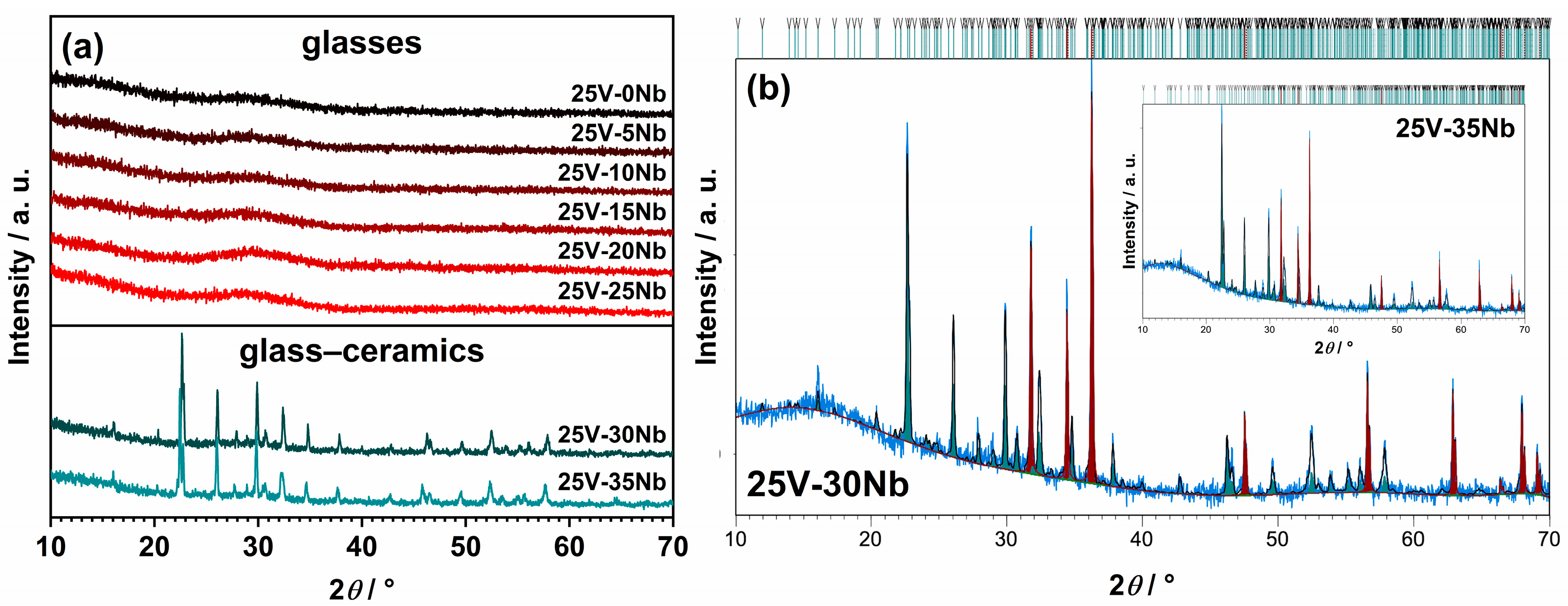
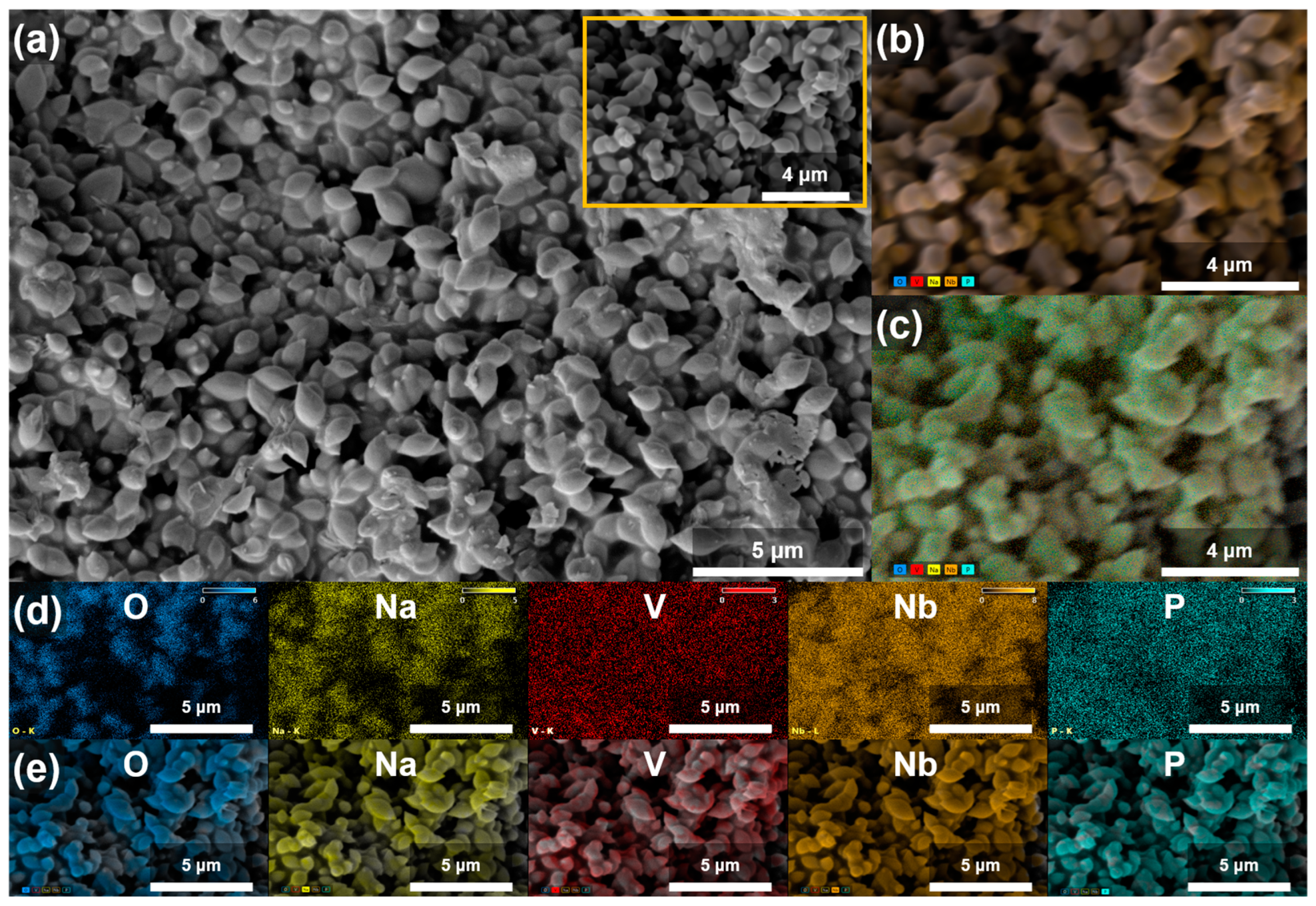
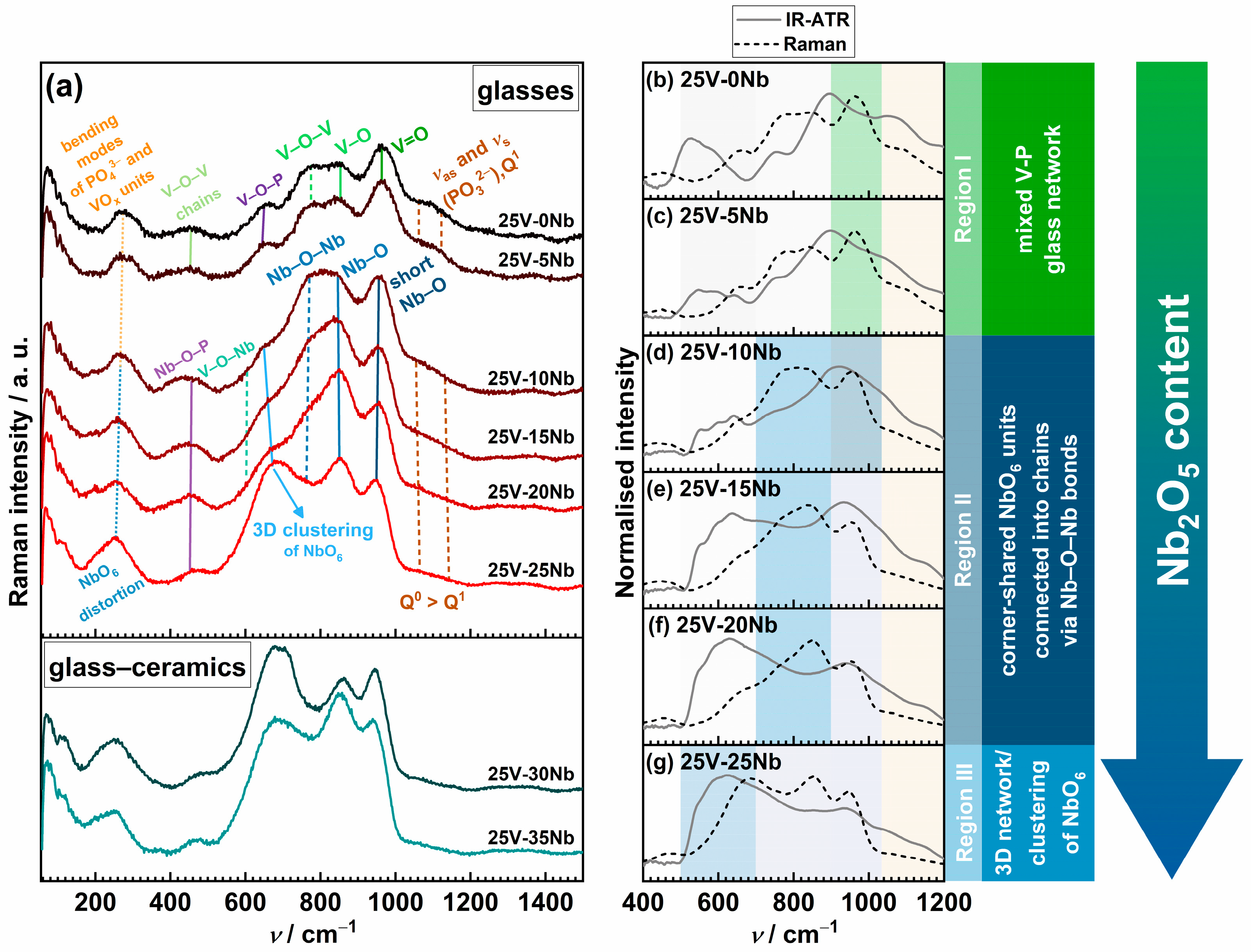
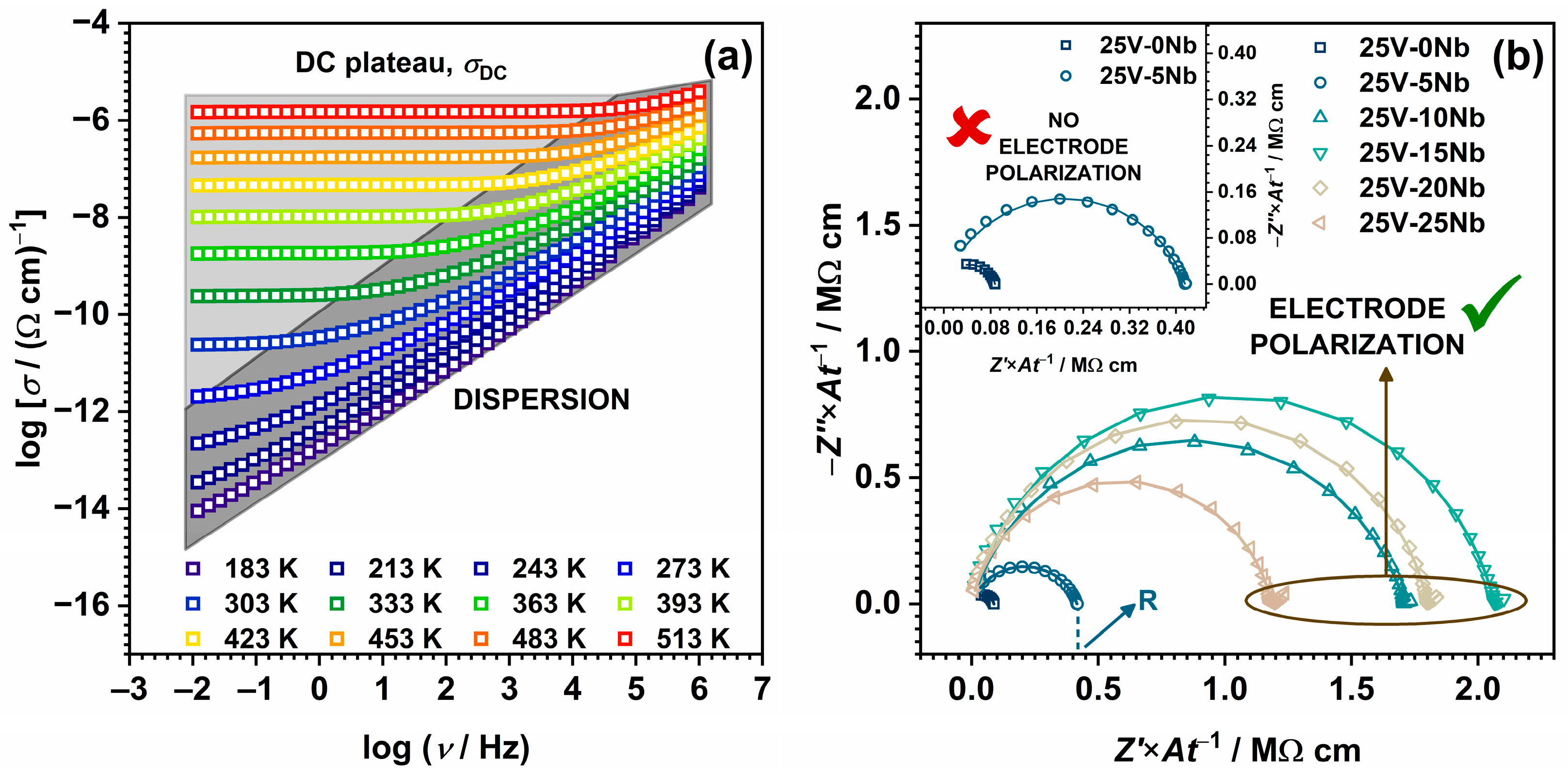
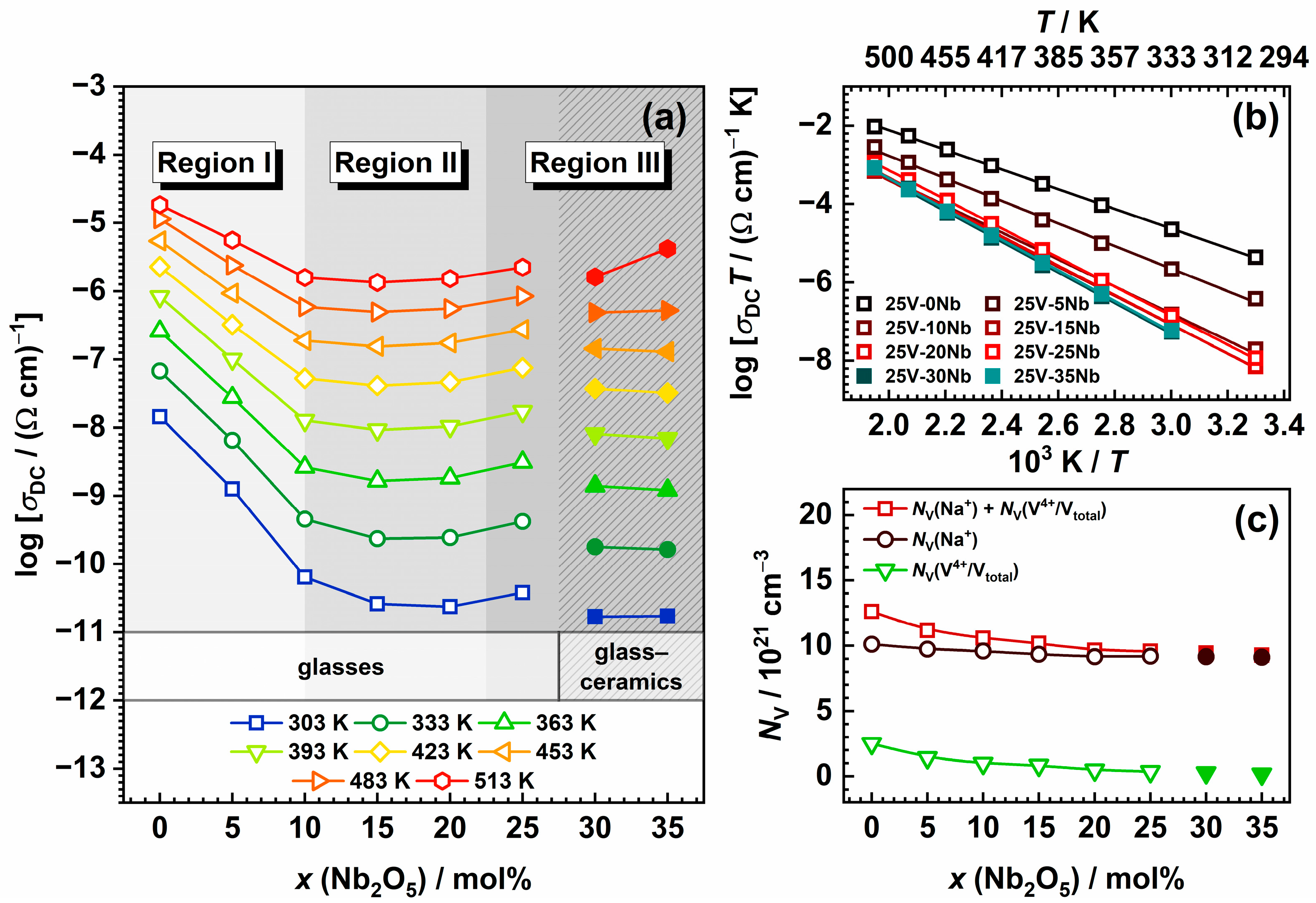
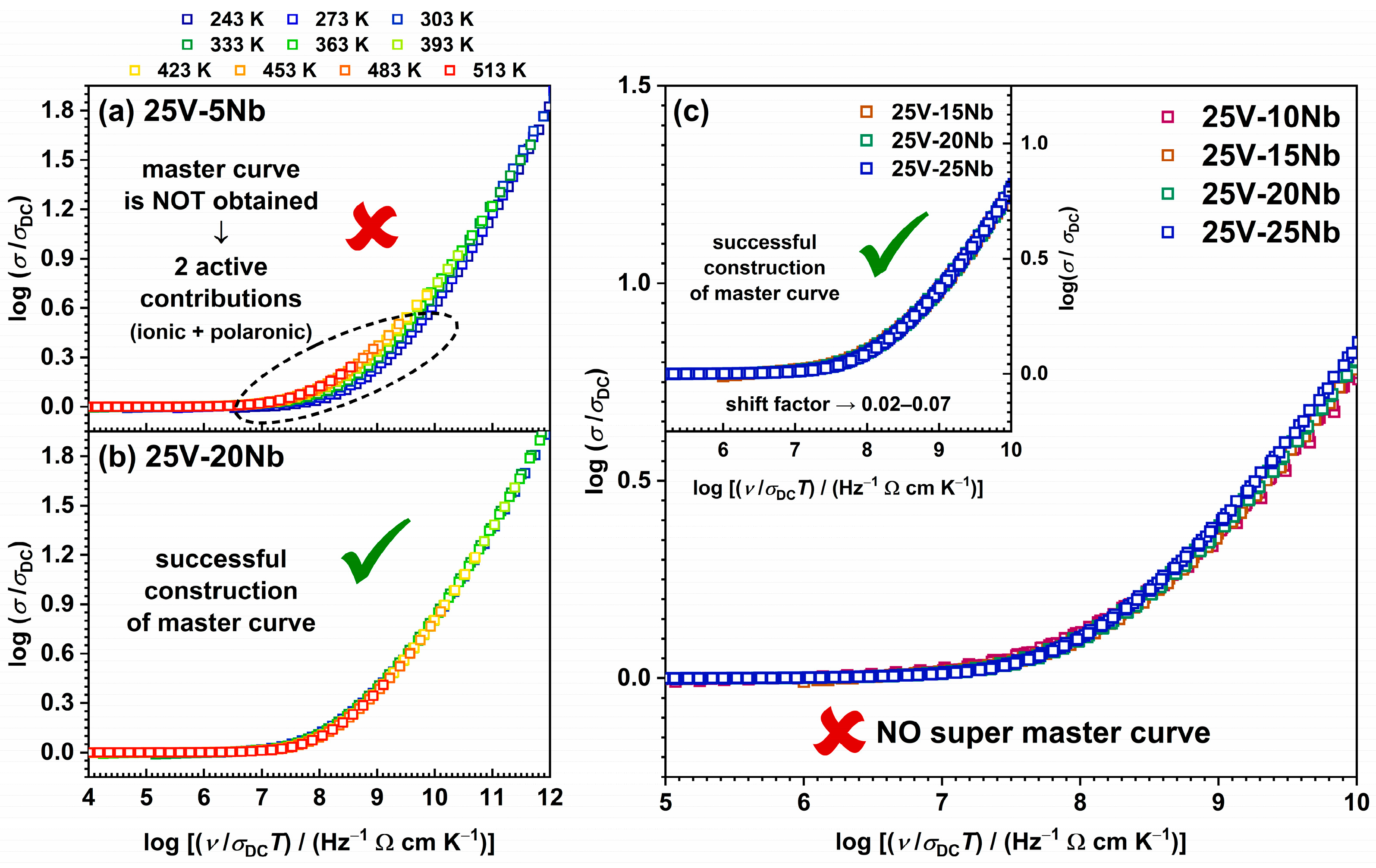
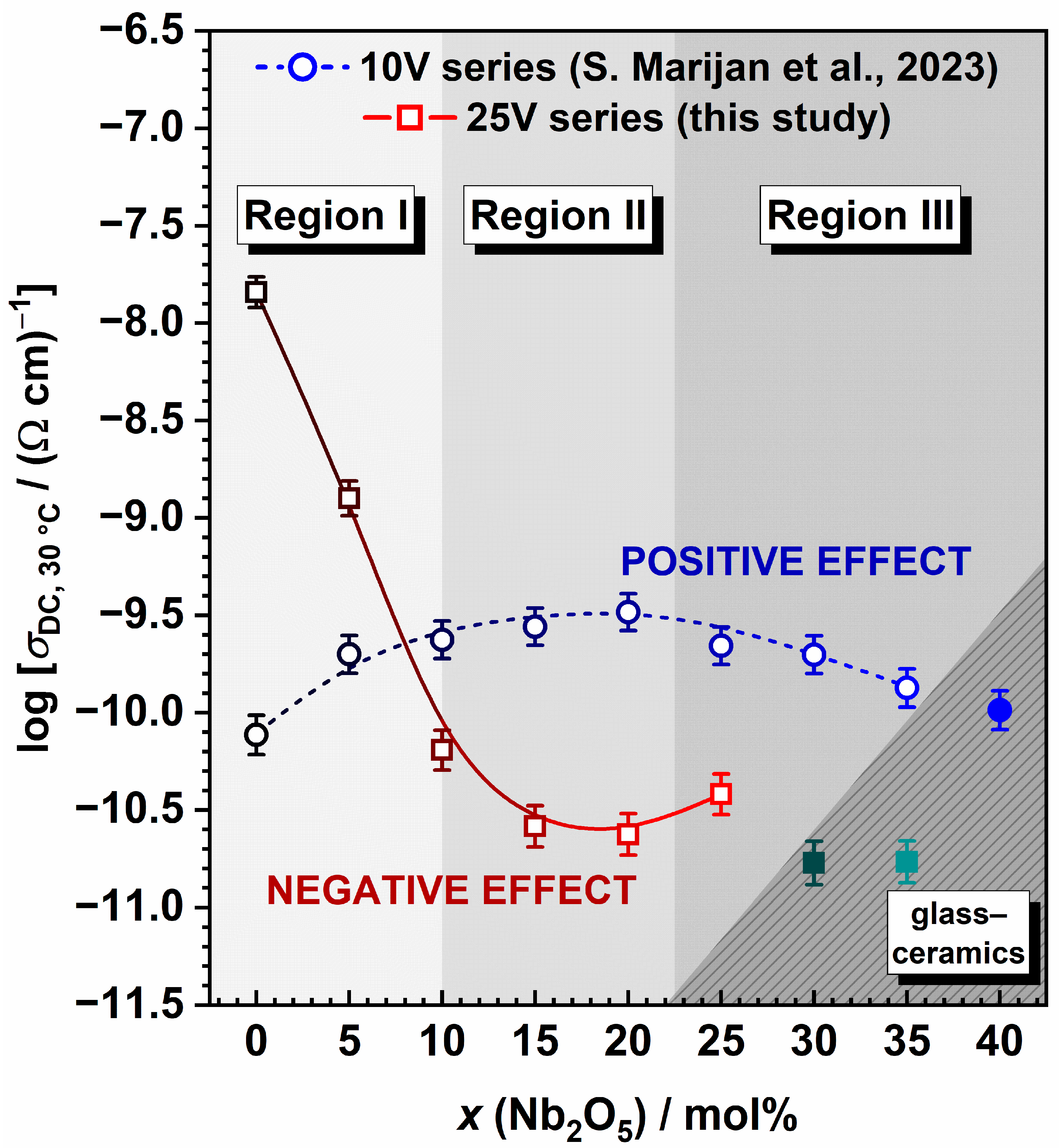
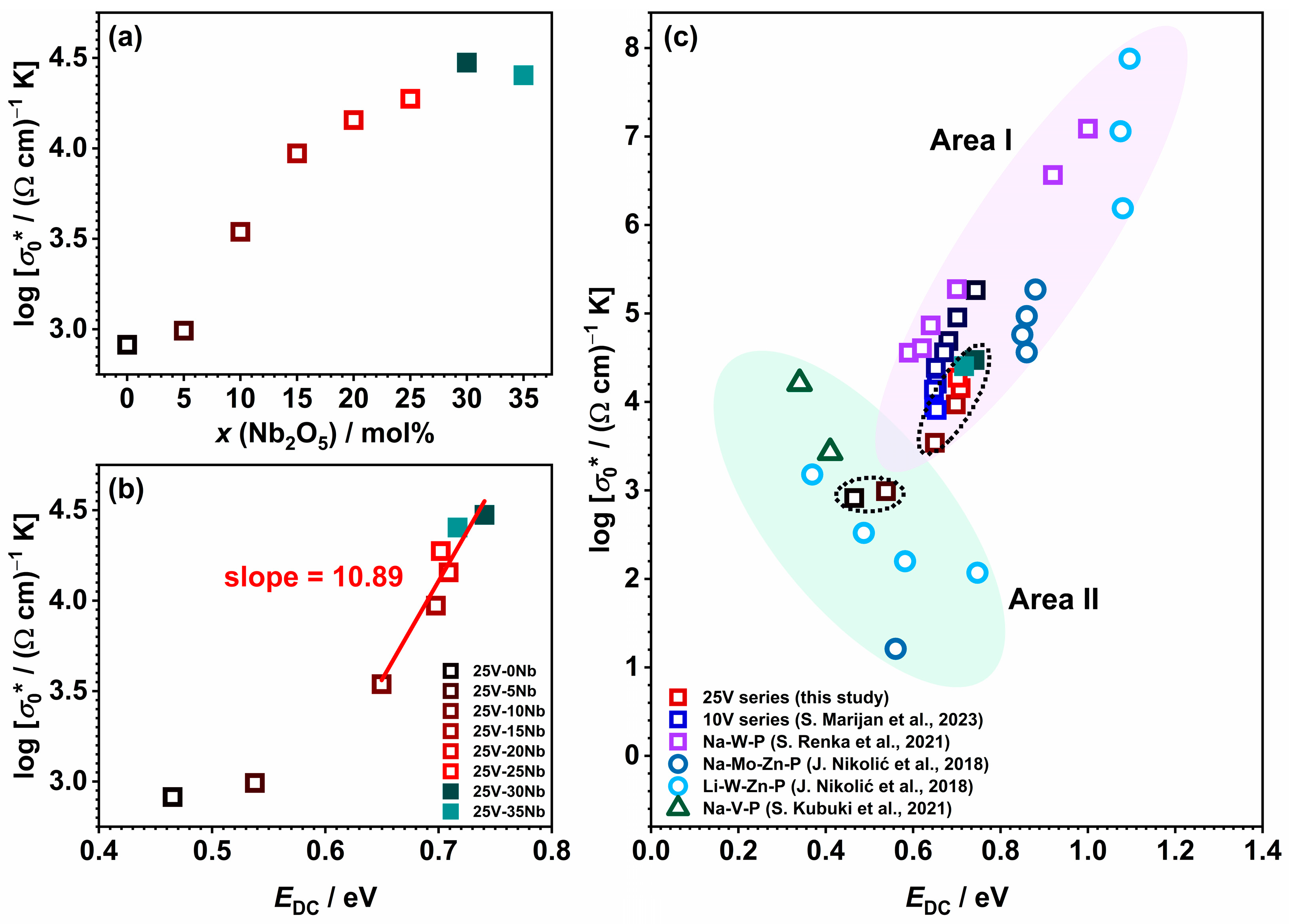
| Sample | x (mol%) | O/P | Ρ (g cm−3) | VM (cm3 mol−1) | Tg (°C) | Tc (°C) | Tc− Tg (°C) | |||
|---|---|---|---|---|---|---|---|---|---|---|
| Na2O | V2O5 | P2O5 | Nb2O5 | |||||||
| 25V-0Nb | 35 | 25 | 40 | 0 | 4.50 | 2.97 | 41.69 | 371 | 450 | 79 |
| 25V-5Nb | 35 | 25 | 35 | 5 | 5.14 | 3.00 | 43.31 | 348 | 439 | 91 |
| 25V-10Nb | 35 | 25 | 30 | 10 | 6.00 | 3.10 | 43.94 | 340 | 434 | 94 |
| 25V-15Nb | 35 | 25 | 25 | 15 | 7.20 | 3.16 | 45.12 | 334 | 444 | 110 |
| 25V-20Nb | 35 | 25 | 20 | 20 | 9.00 | 3.23 | 46.00 | 338 | 450 | 112 |
| 25V-25Nb | 35 | 25 | 15 | 25 | 12.00 | 3.38 | 45.78 | 355 | 468 | 113 |
| 25V-30Nb | 35 | 25 | 10 | 30 | - | 3.50 | - | 230 | 357 | 127 |
| 25V-35Nb | 35 | 25 | 5 | 35 | - | 3.61 | - | 201 | 284 | 83 |
| Sample | σDC at 303 K (Ω−1 cm−1) | EDC (eV) | log σ0* (Ω−1 cm−1 K) | Nv (Na+) (1021 cm−3) | Nv (V4+/Vtotal) (1021 cm−3) | V4+/Vtotal (%) |
|---|---|---|---|---|---|---|
| 25V-0Nb | 1.44 × 10−8 | 0.47 | 2.91 | 10.1 | 2.5 | 34.7 |
| 25V-5Nb | 1.26 × 10−9 | 0.57 | 2.99 | 9.7 | 1.4 | 20.5 |
| 25V-10Nb | 6.43 × 10−11 | 0.68 | 3.54 | 9.6 | 1.0 | 14.4 |
| 25V-15Nb | 2.61 × 10−11 | 0.73 | 3.97 | 9.3 | 0.8 | 12.6 |
| 25V-20Nb | 2.37 × 10−11 | 0.74 | 4.16 | 9.2 | 0.5 | 7.4 |
| 25V-25Nb | 3.81 × 10−11 | 0.74 | 4.27 | 9.2 | 0.4 | 5.6 |
| 25V-30Nb | 1.69 × 10−11 | 0.78 | 4.47 | 9.2 | 0.3 | 4.3 |
| 25V-35Nb | 1.72 × 10−11 | 0.77 | 4.40 | 9.1 | 0.2 | 2.7 |
Disclaimer/Publisher’s Note: The statements, opinions and data contained in all publications are solely those of the individual author(s) and contributor(s) and not of MDPI and/or the editor(s). MDPI and/or the editor(s) disclaim responsibility for any injury to people or property resulting from any ideas, methods, instructions or products referred to in the content. |
© 2024 by the authors. Licensee MDPI, Basel, Switzerland. This article is an open access article distributed under the terms and conditions of the Creative Commons Attribution (CC BY) license (https://creativecommons.org/licenses/by/4.0/).
Share and Cite
Marijan, S.; Klaser, T.; Mirosavljević, M.; Mošner, P.; Koudelka, L.; Skoko, Ž.; Pisk, J.; Pavić, L. Exploring the Effect of V2O5 and Nb2O5 Content on the Structural, Thermal, and Electrical Characteristics of Sodium Phosphate Glasses and Glass–Ceramics. Int. J. Mol. Sci. 2024, 25, 3005. https://doi.org/10.3390/ijms25053005
Marijan S, Klaser T, Mirosavljević M, Mošner P, Koudelka L, Skoko Ž, Pisk J, Pavić L. Exploring the Effect of V2O5 and Nb2O5 Content on the Structural, Thermal, and Electrical Characteristics of Sodium Phosphate Glasses and Glass–Ceramics. International Journal of Molecular Sciences. 2024; 25(5):3005. https://doi.org/10.3390/ijms25053005
Chicago/Turabian StyleMarijan, Sara, Teodoro Klaser, Marija Mirosavljević, Petr Mošner, Ladislav Koudelka, Željko Skoko, Jana Pisk, and Luka Pavić. 2024. "Exploring the Effect of V2O5 and Nb2O5 Content on the Structural, Thermal, and Electrical Characteristics of Sodium Phosphate Glasses and Glass–Ceramics" International Journal of Molecular Sciences 25, no. 5: 3005. https://doi.org/10.3390/ijms25053005
APA StyleMarijan, S., Klaser, T., Mirosavljević, M., Mošner, P., Koudelka, L., Skoko, Ž., Pisk, J., & Pavić, L. (2024). Exploring the Effect of V2O5 and Nb2O5 Content on the Structural, Thermal, and Electrical Characteristics of Sodium Phosphate Glasses and Glass–Ceramics. International Journal of Molecular Sciences, 25(5), 3005. https://doi.org/10.3390/ijms25053005









